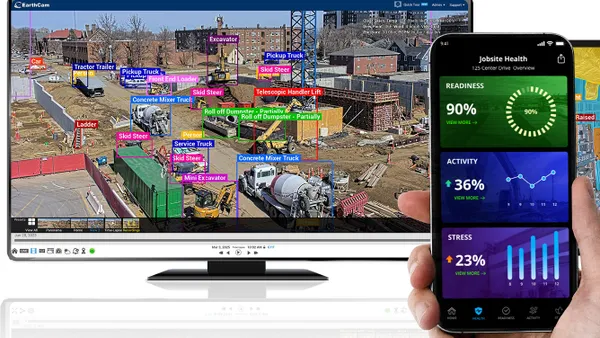Dive Brief:
- New wearable technology could help prevent struck-by and caught-between injuries and incidents, found a study from the University of Nevada, Las Vegas released last month by the Center for Construction Research and Training (CPWR). The study outfitted workers with waist belts with vibrating motors to detect possible nearby hazards.
- The tactile system, designed to notify workers through vibrations, was able to deliver information through signal intensity and duration, notifying them where nearby heavy machinery was operating.
- Participants had their eyes covered and used the vibrational feedback to determine the location of potential hazards and move away from them. The tasks were completed with an estimated 95% accuracy, the study said.
Dive Insight:
The UNLV study determined that more spacing between vibration motors resulted in better signal communication than when the 10 motors were placed closer together. The motors were then used to create a full, tactile-based language, which allowed the worker to determine relative location, level of hazard and the type of equipment that entered the work zone.
Jee Park, assistant professor of civil and environmental engineering and construction at UNLV, and one of the study’s researchers, said he learned about the potential for the brain to learn from “sensory substitution” from decades-old neuroscience research, and wanted to see how it could be applied to construction issues.
“We often have problems of communication and becoming aware of hazards, especially in harsh environments,” Park said. “To me, this looked to be a great way to overcome this problem.”
Wearing the belt is similar to wearing any other belt, Park told Construction Dive and the notification system is user friendly.
Park said there are uncertainties about marketing the product since it is still a prototype and the design could be made more effective, but the communication system can be made for about $50 per set.
The belts are a kind of prototype known as an Embedded Safety Communication System (ESCS). The research team plans to seek additional funding from the National Science Foundation and local construction companies to further develop ESCSs.
Struck-by and caught-in deaths are two of construction’s “Fatal Four,” as deemed by OSHA, contributing to 8.2% and 5.1% of total deaths in construction in 2017, respectively. Electrocutions and falls round out the “Fatal Four” as the most common causes of death.
Wearable applications that receive more attention in the construction industry include exoskeletons — suits designed to lessen muscle pain and strain caused by repetitive work— and equipment for tracking devices for individual workers onsite and improving response time in case of injury.














